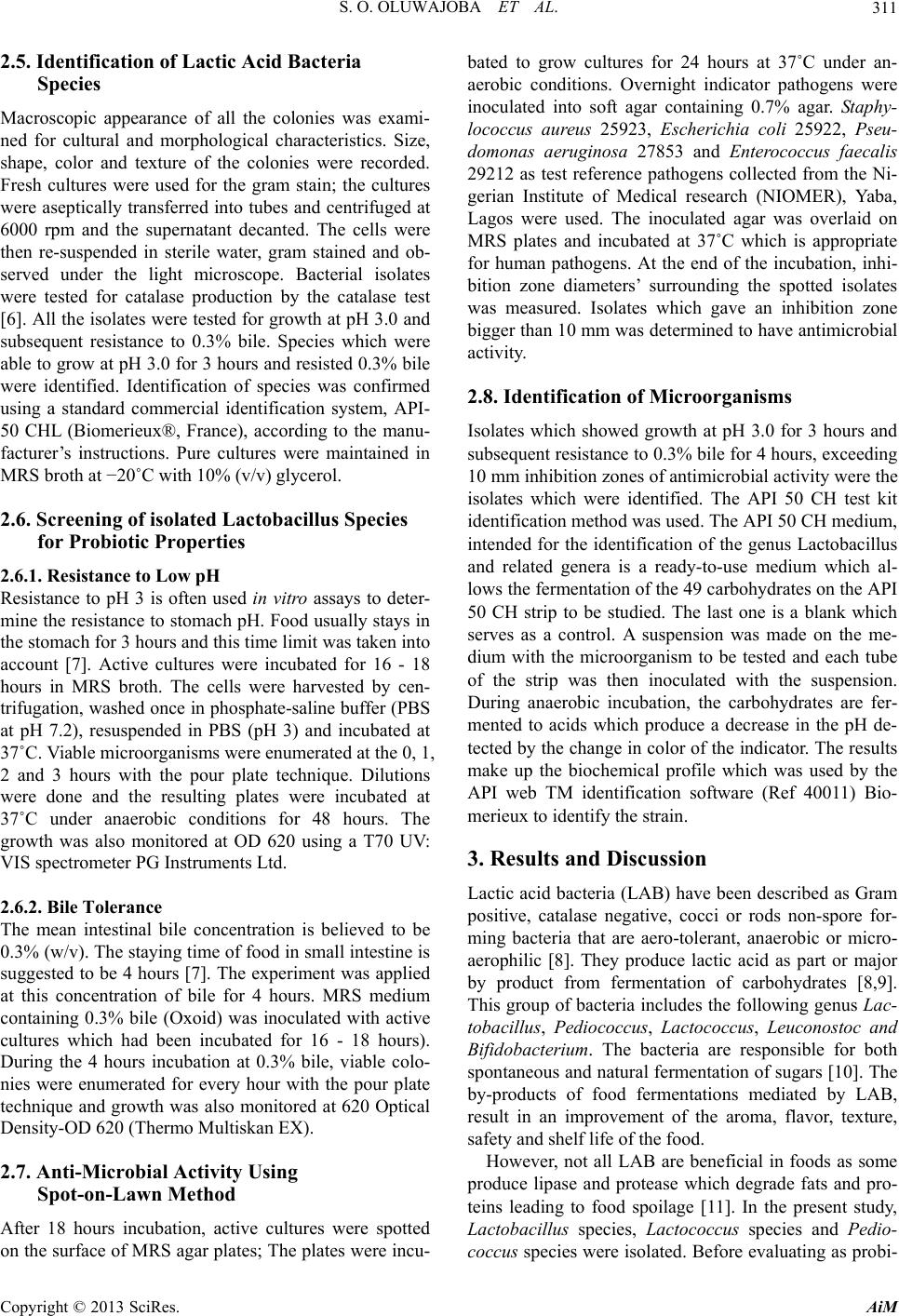
S. O. OLUWAJOBA ET AL. 311
2.5. Identification of Lactic Acid Bacteria
Species
Macroscopic appearance of all the colonies was exami-
ned for cultural and morphological characteristics. Size,
shape, color and texture of the colonies were recorded.
Fresh cultures were used for the gram stain; the cultures
were aseptically transferred into tubes and centrifuged at
6000 rpm and the supernatant decanted. The cells were
then re-suspended in sterile water, gram stained and ob-
served under the light microscope. Bacterial isolates
were tested for catalase production by the catalase test
[6]. All the isolates were tested for growth at pH 3.0 and
subsequent resistance to 0.3% bile. Species which were
able to grow at pH 3.0 for 3 hours and resisted 0.3% bile
were identified. Identification of species was confirmed
using a standard commercial identification system, API-
50 CHL (Biomerieux®, France), according to the manu-
facturer’s instructions. Pure cultures were maintained in
MRS broth at −20˚C with 10% (v/v) glycerol.
2.6. Screening of isolated Lactobacillus Species
for Probiotic Properties
2.6.1. Resistance to Low pH
Resistance to pH 3 is often used in vitro assays to deter-
mine the resistance to stomach pH. Food usually stays in
the stomach for 3 hours and this time limit was taken into
account [7]. Active cultures were incubated for 16 - 18
hours in MRS broth. The cells were harvested by cen-
trifugation, washed once in phosphate-saline buffer (PBS
at pH 7.2), resuspended in PBS (pH 3) and incubated at
37˚C. Viable microorganisms were enumerated at the 0, 1,
2 and 3 hours with the pour plate technique. Dilutions
were done and the resulting plates were incubated at
37˚C under anaerobic conditions for 48 hours. The
growth was also monitored at OD 620 using a T70 UV:
VIS spectrometer PG Instruments Ltd.
2.6.2. Bile Tolerance
The mean intestinal bile concentration is believed to be
0.3% (w/v). The staying time of food in small intestine is
suggested to be 4 hours [7]. The experiment was applied
at this concentration of bile for 4 hours. MRS medium
containing 0.3% bile (Oxoid) was inoculated with active
cultures which had been incubated for 16 - 18 hours).
During the 4 hours incubation at 0.3% bile, viable colo-
nies were enumerated for every hour with the pour plate
technique and growth was also monitored at 620 Optical
Density-OD 620 (Thermo Multiskan EX).
2.7. Anti-Microbial Activity Using
Spot-on-Lawn Method
After 18 hours incubation, active cultures were spotted
on the surface of MRS agar plates; The plates were incu-
bated to grow cultures for 24 hours at 37˚C under an-
aerobic conditions. Overnight indicator pathogens were
inoculated into soft agar containing 0.7% agar. Staphy-
lococcus aureus 25923, Escherichia coli 25922, Pseu-
domonas aeruginosa 27853 and Enterococcus faecalis
29212 as test reference pathogens collected from the Ni-
gerian Institute of Medical research (NIOMER), Yaba,
Lagos were used. The inoculated agar was overlaid on
MRS plates and incubated at 37˚C which is appropriate
for human pathogens. At the end of the incubation, inhi-
bition zone diameters’ surrounding the spotted isolates
was measured. Isolates which gave an inhibition zone
bigger than 10 mm was determined to have antimicrobial
activity.
2.8. Identification of Microorganisms
Isolates which showed growth at pH 3.0 for 3 hours and
subsequent resistance to 0.3% bile for 4 hours, exceeding
10 mm inhibition zones of antimicrobial activity were the
isolates which were identified. The API 50 CH test kit
identification method was used. The API 50 CH medium,
intended for the identification of the genus Lactobacillus
and related genera is a ready-to-use medium which al-
lows the fermentation of the 49 carbohydrates on the API
50 CH strip to be studied. The last one is a blank which
serves as a control. A suspension was made on the me-
dium with the microorganism to be tested and each tube
of the strip was then inoculated with the suspension.
During anaerobic incubation, the carbohydrates are fer-
mented to acids which produce a decrease in the pH de-
tected by the change in color of the indicator. The results
make up the biochemical profile which was used by the
API web TM identification software (Ref 40011) Bio-
merieux to identify the strain.
3. Results and Discussion
Lactic acid bacteria (LAB) have been described as Gram
positive, catalase negative, cocci or rods non-spore for-
ming bacteria that are aero-tolerant, anaerobic or micro-
aerophilic [8]. They produce lactic acid as part or major
by product from fermentation of carbohydrates [8,9].
This group of bacteria includes the following genus Lac-
tobacillus, Pediococcus, Lactococcus, Leuconostoc and
Bifidobacterium. The bacteria are responsible for both
spontaneous and natural fermentation of sugars [10]. The
by-products of food fermentations mediated by LAB,
result in an improvement of the aroma, flavor, texture,
safety and shelf life of the food.
However, not all LAB are beneficial in foods as some
produce lipase and protease which degrade fats and pro-
teins leading to food spoilage [11]. In the present study,
Lactobacillus species, Lactococcus species and Pedio-
coccus species were isolated. Before evaluating as probi-
Copyright © 2013 SciRes. AiM